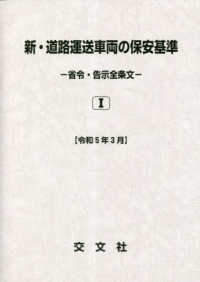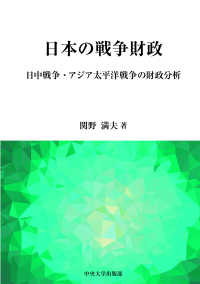- ホーム
- > 洋書
- > 英文書
- > Nature / Ecology
Full Description
Societies have sought to improve the outputs of their agricultural producers for thousands of years. In the 19th and early 20th centuries, efforts to convey agricultural knowledge to farmers became known as extension services, a term adopted from programs at Oxford and Cambridge designed to extend the knowledge generated at universities to surrounding communities. Traditionally, extension services have emphasized a top-down model of technology transfer that encourages and teaches producers to use crop and livestock varieties and agricultural practices that will increase food production. More recently, extension services have moved toward a facilitation model, in which extension agents work with producers to identify their needs and the best sources of expertise to help meet those needs.
On May 1, 2012, the Roundtable on Science, Technology, and Peacebuilding held a workshop in Washington, DC, to explore whether and how extension activities could serve peacebuilding purposes. The Roundtable is a partnership between the National Academy of Engineering (NAE) and the U.S. Institute of Peace (USIP). It consists of senior executives and experts from leading governmental organizations, universities, corporations, and nongovernmental organizations, was established in 2011 to make a measurable and positive impact on conflict management, peacebuilding, and security capabilities. Its principal goals are:
To accelerate the application of science and technology to the process of peacebuilding and stabilization;
To promote systematic, high-level communication between peacebuilding and technical organizations on the problems faced and the technical capabilities required for successful peacebuilding; and
To collaborate in applying new science and technology to the most pressing challenges for local and international peacebuilders working in conflict zones.
Table of Contents
Front Matter
1 Introduction
2 Conflict in Rural Settings
3 Extension Services in Fragile Societies
4 Capacity Building and Training
5 Organizational Change and Institution Building
6 Technological Infrastructure
7 Final Observations
Appendix A: Agenda
Appendix B: Attendees
Contents
1 Front Matter; 2 1 Introduction; 3 2 Conflict in Rural Settings; 4 3 Extension Services in Fragile Societies; 5 4 Capacity Building and Training; 6 5 Organizational Change and Institution Building; 7 6 Technological Infrastructure; 8 7 Final Observations; 9 Appendix A: Agenda; 10 Appendix B: Attendees








